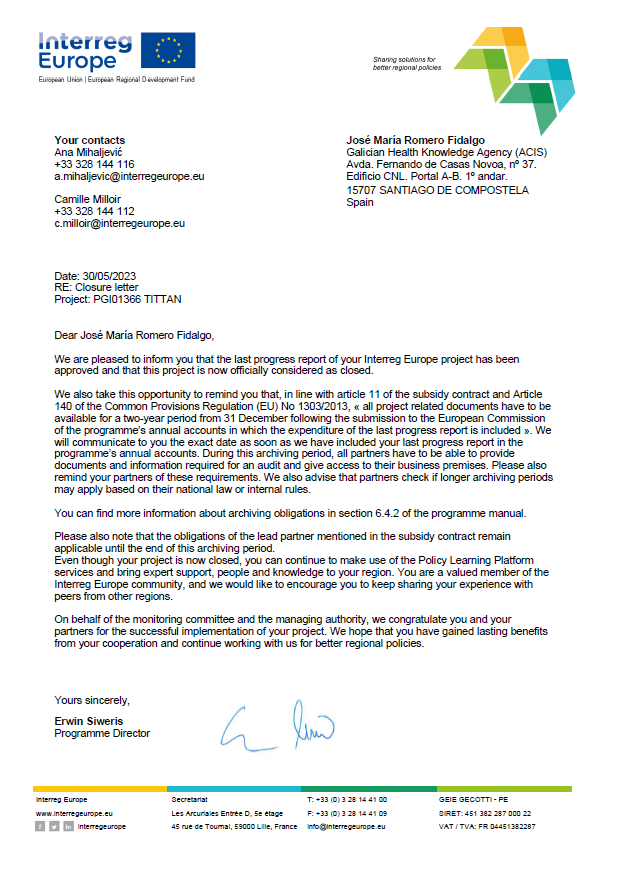
Official TITTAN project closure
The Interreg Joint Secretariat congratulates the TITTAN consortium for the successful implementation of the project

The TITTAN COVID-19 project (Translation, Innovation & Technology Transfer in Ageing Network in the context of the COVID-19 pandemic), aims to establish a knowledge exchange network within five European regions to promote innovation and technology transfer in the field of the COVID-19 pandemic. The TITTAN COVID-19 project extension lasts a year and a half and is funded through the Interreg Europe Program.
TITTAN Network for Technology, Innovation and Translation in Ageing
European population is ageing rapidly. The number of people aged 65 and over is projected to increase from 14% in 2010 to 25% in 2050. Advances in science and technology contribute to prolong people lifespan, but unfortunately that does not mean they will be healthier. In its headline strategic document “EU2020 Strategy”, the EC has identified active and healthy ageing as a major societal challenge common to all European Countries.
The TITTAN project (Network for Technology, Innovation and Translation in Ageing) aims to tackle that challenge, by improving the quality and performance of the European regional healthcare systems in relation with the healthy and active ageing. Its specific objective is to exchange, benchmark and implement good practices and measures in 7 European regions about policies which can foster the design, up-taking and use of innovative technology-based products/solutions. The TITTAN learning approach is focused on 3 Thematic Areas (TAs): how to uptake innovative health products/services through new public procurement practices (PCP and PPI); how to promote the establishment of innovation ecosystems in the health sector; how to raise citizen´s awareness about using new technologies for improving quality of life.The project is promoted by a well-balanced partnership, which involves 7 European regions: Galicia (lead partner), Basque Country, Scotland, the Metropolitan Area of Amsterdam, Lombardy, Saxony and Lower Silesia. The strong ties among them - coming from the cooperation in previous projects and the active participation in the EIP-Active and Healthy Ageing – represents an added-value for the partnership.
TITTAN will contribute to improve 7 regional policy instruments. all of them are linked to the EU Structural Funds. Thus,TITTAN will provide partner regions with the opportunity to orientate the spending process of the Structural Funds towards some of the most-effective and result-oriented policy practices for healthy and active ageing.
€1,784,916.00
Research and innovation
The European TITTAN Project, aims to tackle the challenge of ageing, by creating a network of communication for interchanging good practices that can foster the design, innovation and technology transfer, up-taking and use of innovative products/solutions for this problem, for improving the quality of life of elderly people and improving the performance of the European regional healthcare systems too.
The Galician ERDF Operational Program (OP) has been approved in March 2015, aligning with Europe 2020 targets and the Regional Specialization Strategy. The area of health and especially the field of Active Ageing and Healthy living, are among the highest priorities for the region.The Galician OP has been divided in 10 Thematic Objectives (TOs).TO1 aims to foster Research and innovation development in the region.
Galicia aims to become a lead region in Southern Europe that offers knowledge-intensive products and services linked to a healthy lifestyle model. Under this framework the Galician Regional Health Government is aware of the challenges ahead.Galician senior population (more than 65 years old) reached in 2015 23% of the total population. Besides, a considerable part of Galician people live in rural areas and the management of healthcare services are most expensive. Innovation seems the only solution to overcome current health challenges. Since 2011,our region collaborates with other European regions in the development of European and participating actively in some of the most important initiatives developed at EU level (KIC, EIPonAHA, etc).Long term collaborations and exchange of good practices can be a very powerful measure to incorporate successful strategies implemented by other European regions in Galicia.The final goal is to increase the quality of life of our patients, guaranteeing a sustainable healthcare system through the incorporation of innovative policies.
The ERDF Operational Program 2014-2020 of the Basque Country is the document in which the strategy and thematic objectives of intervention are set up in the region. It addressed finance activities by the ERDF for the new programming period 2014-2020, and the financial arrangements set for these objectives. The ERDF Programme put special focus on the thematic objectives addressed to promote the smart specialisation strategy in Europe 2020 : R+D+I (OT1), TICs (OT2), SMEs (OT3) and Low Economy and Carbon (OT4).
The OP measures addressed through the TITTAN project are as follows :
- Thematic objective 1 (R+D+I), where there is a specific mention on boosting the R+D+I on ageing and health by promoting the technological convergence to fill gap markets on ageing, health and others (page 12 of the document).
- Thematic objective 3 (to improve the competitiveness of the SMEs), to which creating new services, products for ageing population, and health, is one of its main issues (page 15 of the document).
The strategic approach and the expected achievements of the Basque Country´s ERDF OP are different from the ones of Galicia, considering that - according to the Cohesion Policy classification of regions - it is a long-stading "More Developed" region, whereas Galicia is a newcomer "More Develope" region. Therefore, the participation of both regions in the project can surely enrich the learning process, even tough they are from the same Country.
The ERDF Operational Programme of the Region of Lombardy is the regional policy instrument that manages ERDF funds. The measure concerned by the TITTAN project is the Axis I “Strengthening research, technological development and innovation”, with a focus on the following areas:
- promotion of new markets for innovation – support to PCP and PPI actions;
- support of projects concerning the regional innovation strategy for smart specialization (RIS3) – of which one of the specific work programmes is active ageing;
- support to actions enabling the regional stakeholders to participate in innovation platforms, such as clusters, as well as to participate in European programmes for research and innovation;
- enhancing the level of innovation practised by business, with the intent also, but not exclusively, of industrialising research results.
The Operational Programme could profit from the expertise of other European regions, particularly if it helped to find ways to enhance the transfer of transnational research results to businesses, and in policies and projects concerning the innovative thematic of telehealth and its application in the public healthcare system.
The ERDF Operational Programme of the Free State of Saxony is the regional policy instrument that manages ERDF funds. It has been approved by the Saxonian government in November 2014 as a result of detailed consideration regarding regional challenges as well as overall investment priorities. Extensive parts of this programme align with priorities of the Europa 2020 Smart Specialisation Strategy, e.g. to foster research, development and innovations, reduce CO2-Emissions, the adjustment to climatic changes as well as the preservation oft he environment and many more.
The improvement of healthcare through more resourceful and innovative technology-based measures is among the top priorities of the region. The rate of population under the age 20 decreased from 24% in 1990 to 15% in 2012 while the rate of senior population (age 65 or higher) increased during the same period from 16% to 25%. It is expected that the amount of senior population will be increased up to the rate of 33% by 2025 while the rate of the younger population will hardly increase. Furthermore a remarkable amount of the saxonian population lives in rural areas where medicinical provision and healthcare are far less marked than in urban regions. Only by fostering and implementing technology-based innovations, Saxony can take on the distinctive demographic and healthcare challenges mentioned above.
Innovation is a key driver of productivity growth, and Scotland has a strong base of innovation to build on. As Scotland's Economic Strategy makes clear, improvements in innovation enable businesses to become more competitive, grow more quickly, enter new markets and become more resilient to change. The Scottish Government is fully committed to ensuring that Scotland becomes an innovation nation, and has a portfolio of supporting actions to achieve this.
The Scottish Government is supporting ambitious collaborations between businesses, universities and others to capitalise on Scotland's world-class research through a network of Innovation Centres. There are currently eight in Scotland, and the Digital Health Institute is one of them. DHI plays a hub role in the Scottish health and care ecosystem and has a main focus on ageing, a potential domain for innovation. In addition to supporting innovation activity in Scotland, the Scottish Government will support international collaboration by piloting Innovation and Investment Hubs at key global locations, and this project could be an enabler for its development.
The 20202 Development Strategy for the Lower Silesia is the most important document of the Voivodeship setting out mid-term policy direction. It is implemented in accordance with the national and Community legislation, in particular with the Act on the National Development Plan and the Council Regulation laying down general provisions on structural funds and the Cohesion Fund. Account was also taken of the Council Regulation on the ERDF, the ESF and the Cohesion Fund in the new European Union financing perspective. Among the Strategy´s eight priorities, it has to be mentioned the regional development based on the cluster cooperation, Development of entrepreneurship and innovation, the intensification of cooperation economy-science-administration.
One of the main objectives of the policy instrument is the achievement of a better healthcare queality, to ensure accessibility to certain types of benefits, taking into account the long-term demographic trends. An important direction of activity is the development and support innovative solutions raising the quality and availability of services.The improvement of the policy instrument will consist in promoting technological innovations in the health sector, by introducing new products and services and changing the manner in which the services are provided.
The OP Kansen voor West II has been build in cooperation with 8 partners (4 Provinces and 4 cities in Western Netherlands), with the aim of achieving the EU2020S objectives. The emphasis is on innovation & investment into R&D.
In particualr, the four big cities involved (among them, Amsterdam) face specific challenges, as sections of these cities seem to 'miss their connection' to current economic developments, because of ageing, which is felt more strongly is densely populated areas. In some parts, ageing appears to give rise to an economic and social divide.
The TITTAN project has a synergy with two of the priority axis of the OP:
a) Axis "Innovation" : focus is on providing innovative solutions to societal challenges and needs that are of a composite nature, for instance, as food and health and work and health. Solutions to these composite needs will increasingly have to be developed by connecting new technologies to the sectors. Life Sciences and Health, and especialy healthy ageing/vitality is one of the main sectors which is mentioned (p. 6 of the OP). Focus will be on accelerating the implementation of new technologies in health, thereby supporting specific objective 2 and 3 of the TITTAN project.
b) Axis "Promoting social inclusion and combating poverty", Investment priority 9b: it is coherent with the TO3 of TITTAN,, which aim to raise awareness among citizens about the importance of using new technologies for improving quality of life and lifespan.

The Interreg Joint Secretariat congratulates the TITTAN consortium for the successful implementation of the project
Project activity report and collection of good practices COVID-19

TITTAN COVID19 – Final Conference : "COVID-19 & THE FUTURE OF HEALTHCARE", 27th Sep 2022
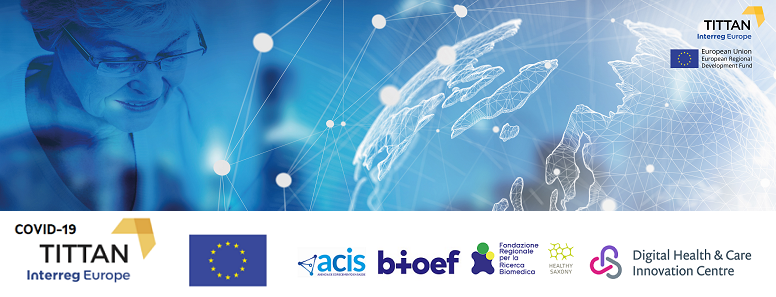
TITTAN COVID19 – Knowledge Exchange Workshop : Patient Empowerment, 21st June 2022
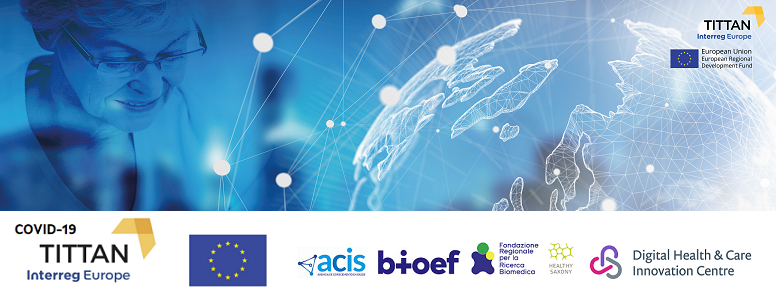
TITTAN COVID19 – Knowledge Exchange Workshop : AHA Ecosystems 4th May 2022
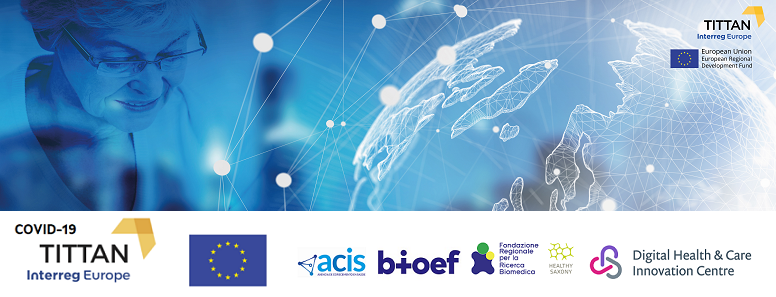
TITTAN COVID19 – Knowledge Exchange Workshop for Health Care Delivery Pathways 14th March 2022
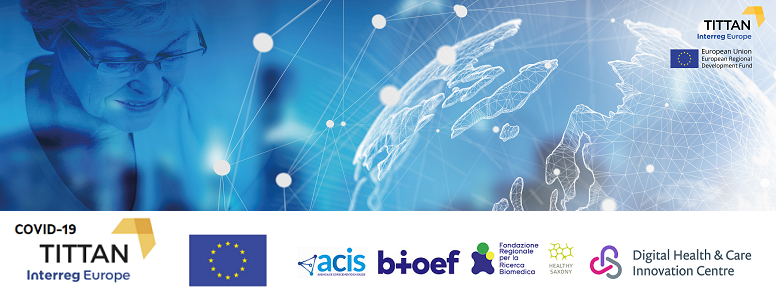
Translation, Innovation & Technology Transfer in Ageing Network in the context of the COVID-19 pandemic
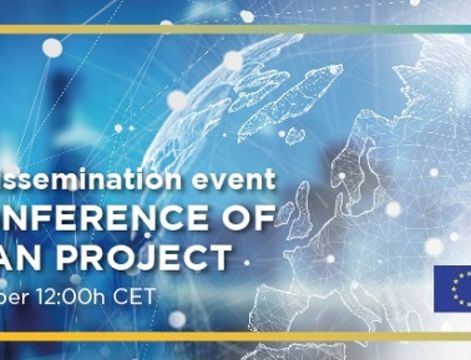
High-level dissemination event of the TITTAN project
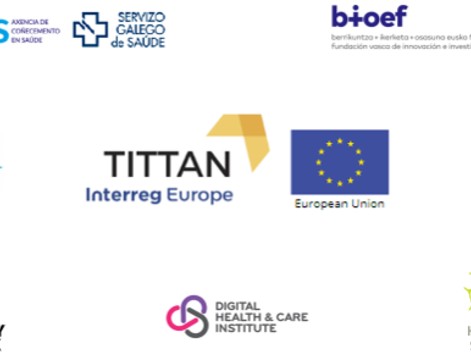
The High-level dissemination event of the TITTAN Interreg Europe project will be held online on 1 December 2020, 12:00 - 14:15 CET.
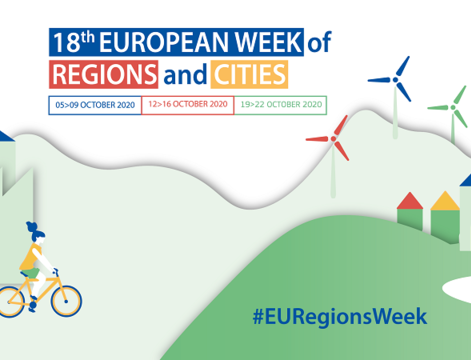
TITTAN will participate in the great event “European Week of Regions and Cities” with a Talk about patients empowerment.